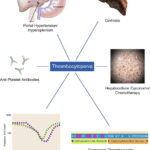Thrombocytosis is defined as a sustained elevation in platelet count exceeding 450,000/μL. When occurring in the context of myeloproliferative neoplasms (MPNs), this hematologic abnormality is typically a result of clonal proliferation of megakaryocytes in the bone marrow. Unlike reactive thrombocytosis, which is a response to inflammation or tissue damage, MPN-related thrombocytosis reflects an intrinsic defect in hematopoietic stem cell regulation.
The primary MPNs associated with thrombocytosis include:
- Essential thrombocythemia (ET)
- Polycythemia vera (PV)
- Primary myelofibrosis (PMF)
- Chronic myeloid leukemia (CML) (less frequently with isolated thrombocytosis)

Pathophysiology of Thrombocytosis in Myeloproliferative Disease
Thrombocytosis in MPNs arises from somatic mutations that drive unchecked hematopoiesis, particularly affecting the megakaryocyte lineage.
Common Mutations Driving Platelet Overproduction
- JAK2 V617F: Present in ~50–60% of ET and ~95% of PV cases, this mutation activates the JAK-STAT signaling pathway, resulting in cytokine-independent proliferation.
- CALR Mutations: Found in ~25–30% of ET and PMF cases. CALR-mutant patients often have higher platelet counts and lower thrombotic risk compared to JAK2-mutant individuals.
- MPL Mutations: Affect the thrombopoietin receptor, promoting uncontrolled platelet production.
Types of Myeloproliferative Neoplasms with Thrombocytosis
Essential Thrombocythemia (ET)
ET is a chronic MPN marked by sustained thrombocytosis without significant elevation in red or white blood cells. Diagnosis requires exclusion of reactive causes and other MPNs. Hallmarks include:
- Persistent platelet count >450 ×10⁹/L
- Clonal mutation (JAK2, CALR, or MPL)
- Bone marrow biopsy showing megakaryocytic hyperplasia
Clinical Risks: Thromboembolic events (arterial and venous), hemorrhage, and rarely progression to myelofibrosis or acute leukemia.
Polycythemia Vera (PV)
PV is characterized by increased red blood cell mass, often accompanied by leukocytosis and thrombocytosis. Elevated erythropoiesis is driven by JAK2 mutations.
Platelet Role: While erythrocytosis predominates, thrombocytosis contributes significantly to thrombotic risk.
Primary Myelofibrosis (PMF)
In early (prefibrotic) stages, PMF may present with marked thrombocytosis. As fibrosis progresses, thrombocytopenia usually ensues. Bone marrow fibrosis, splenomegaly, and systemic symptoms define the clinical picture.
Chronic Myeloid Leukemia (CML)
Though classically associated with leukocytosis, CML may present with isolated thrombocytosis, especially in atypical or early-phase cases. The BCR-ABL1 fusion gene confirms diagnosis.
Differentiating Clonal from Reactive Thrombocytosis
Accurate diagnosis of clonal thrombocytosis is critical to guide management.
| Feature | Reactive Thrombocytosis | MPN-Associated Thrombocytosis |
|---|---|---|
| Cause | Inflammation, infection, trauma | Genetic mutation (JAK2, CALR, MPL) |
| Platelet Count | <800 ×10⁹/L usually | >1000 ×10⁹/L common |
| Morphology | Normal-sized platelets | Large, atypical megakaryocytes |
| Duration | Transient | Persistent |
| Mutation | Absent | Present (JAK2, etc.) |
| Risk of Thrombosis | Low | High |
Clinical Implications of Thrombocytosis in MPNs
1. Thrombosis
High platelet counts in MPNs, particularly in JAK2-mutated ET and PV, significantly increase the risk of thrombosis, including:
- Stroke
- Myocardial infarction
- Deep vein thrombosis
- Pulmonary embolism
- Budd-Chiari syndrome
2. Hemorrhage
Paradoxically, patients with extreme thrombocytosis (>1,000,000/μL) may develop acquired von Willebrand disease (AvWD), predisposing them to bleeding despite elevated platelet counts.
3. Microvascular Disturbances
Symptoms such as erythromelalgia (burning pain in hands/feet), visual disturbances, and headaches may result from microvascular occlusions.
Diagnostic Workup for Thrombocytosis in Suspected MPN
- Complete Blood Count (CBC) with Differential
- Peripheral Blood Smear
- JAK2 V617F Mutation Testing
- CALR and MPL Mutation Analysis (if JAK2 negative)
- Bone Marrow Biopsy and Aspirate
- Serum Erythropoietin (EPO) (to differentiate PV)
- BCR-ABL1 Testing (to exclude CML)
- Coagulation Panel and von Willebrand Factor Assay (if bleeding symptoms present)
Risk Stratification in MPNs with Thrombocytosis
Risk assessment in ET and PV is essential to guide therapeutic decisions. Risk categories are based on age, history of thrombosis, platelet count, and mutation status.
ET Risk Stratification:
- Very Low: Age <60, no thrombosis, JAK2-negative
- Low: Age <60, no thrombosis, JAK2-positive
- Intermediate: Age ≥60, no thrombosis, JAK2-negative
- High: Age ≥60 or history of thrombosis, JAK2-positive
Treatment Strategies for Thrombocytosis in MPN
1. Antiplatelet Therapy
- Low-dose aspirin is recommended in most ET and PV patients unless contraindicated.
- Reduces arterial thrombosis but increases bleeding risk, especially in AvWD.
2. Cytoreductive Therapy
Indicated for high-risk patients or those with symptoms:
| Drug | Mechanism | Notes |
|---|---|---|
| Hydroxyurea | Inhibits DNA synthesis | First-line in high-risk ET and PV |
| Interferon-α | Immunomodulatory | Preferred in young or pregnant patients |
| Anagrelide | Selective megakaryocyte inhibitor | Less thrombotic protection than hydroxyurea |
| Ruxolitinib | JAK1/2 inhibitor | Approved for PV resistant to hydroxyurea |
3. Phlebotomy (for PV)
Used to maintain hematocrit <45% in males and <42% in females, indirectly lowering thrombosis risk.
4. Monitoring and Surveillance
- Routine CBC and mutation burden monitoring
- Annual echocardiography in high-risk patients
- Bone marrow reassessment if disease transformation is suspected
Prognosis and Long-Term Considerations
- ET has the most favorable prognosis among MPNs, with median survival >20 years in low-risk individuals.
- PV patients are at higher risk of thrombotic complications and transformation to myelofibrosis or acute leukemia.
- PMF carries a poorer prognosis, particularly post-fibrotic stage.
- Life-long surveillance and risk-adapted therapy are essential to mitigate complications and preserve quality of life.
Thrombocytosis in myeloproliferative diseases reflects a complex interplay between genetic mutations and dysregulated hematopoiesis. Timely differentiation from reactive causes, identification of driver mutations, and risk-based therapeutic intervention are key to managing the thrombohemorrhagic complications associated with MPNs. With advancements in molecular diagnostics and targeted therapy, patient outcomes continue to improve through precision medicine approaches tailored to each MPN subtype.

